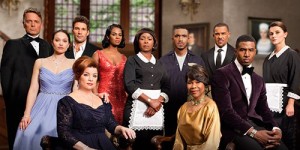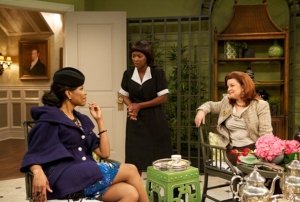Tags
class, family, gender, oprahwinfrey, oprahwinfreynetwork, OWN, power, race, sex, thehavesandthehavenots, tylerperry, wealth
Tyler Perry’s TV drama The Haves and the Have Nots seems to at first be the portrayal of the typical narrative of the master/servant white/black relationship that has been presented many times before by the entertainment industry. The show revolves around the lives of the rich, powerful and white Southern Cryer family (the Haves) who live in an opulent mansion in Savannah, Georgia, and the family’s black hired help Hanna Young and her family (the Have Nots).

Characters left to right: Jim Cryer, Amanda Cryer, Wyatt Cryer, Kathryn Cryer, Candace Young, Hanna Young, Benny Young, Veronica Harrington, David Harrington, Jeffrey Harrington and Celine Gonzales
Produced by the Oprah Winfrey Network (OWN), it is clear from the first episode of the series, which is aptly titled ‘The Big Surprise’, that Tyler Perry intends this show to be a dramatic portrayal of race, gender, sex, class and power through the stories of these two dysfunctional families. The many skeletons hiding in the two families closets that are revealed throughout the first episode alone, such as the Cryer family patriarch, Jim, having sexual affairs with escorts, and then his most recent escort being revealed as not only his daughter’s friend from college, but also the maid Hanna Young’s daughter, emphasises the extreme levels of drama that Perry will be packing into this series.
Tyler Perry once commented in an interview with Oprah Winfrey that the inspiration for this TV drama has come from his own lived experiences as both a young, black boy from a poor background, and his adult life since finding fame and success. He has been both a ‘Have’ and a ‘ Have Not’, and it is highly apparent that he is making a clear dichotomy between these two class groups through the Cryer family and the Young family. The first episode depicts the white Cryer family as powerful, secretive and corrupt, whereas Hanna Young, the newly employed maid, is presented as honest, hardworking and an exceedingly pious woman. This relationship between white and black, employer and employee, is almost reminiscent of master and slave. The personality traits that Perry has created for each group are also evocative of Friedrich Nietzsche’s notion of the ‘master-slave morality’ (Nietzsche, 1887). This is a concept that I will discuss in a future blog post, comparing Hanna Young and the Cryer family.

Left to right: The wealthy Veronica Harrington with the help Hanna Young and mistress of the house Kathryn Cryer.
However, Perry does create a contradicting element to this traditional white employer/black servant concept with the addition of the Harrington’s, a black, wealthy and powerful family, who are close friends with the Cryer’s. The division between the upper class Harrington’s and the lower class Young’s is made thoroughly transparent with Hanna Young’s remark, “I can’t stand black people like that…who think they’re better than everyone else” (10:03). This class tension between the two characters of the same race is an interesting addition to the storyline, and hopefully a notion that Perry develops and explores further in the upcoming episodes.
As someone who does not know a lot about either Tyler Perry or Oprah Winfrey, except that they are globally known African American’s who have risen out of their poor black backgrounds to find fame and success, I chose to blog about this TV show to see and experience the views and themes that are important to both Perry as the writer, and Winfrey whose network produces the show. While it is yet to be seen for the quality of the script and acting in this TV drama, it is evident that Tyler Perry’s ideas and views on race, gender, sex, class and power are abundant and bursting to be revealed in the episodes that follow.

Really strong intro to the show. I actually might start watching a few episodes. After I catch up on my Walking Dead. And Orange Is the New Black. And OJ. And….
LikeLike
Pingback: “Jungle Love”: Slavery’s legacy on black female sexuality | The Haves and the Have Nots
Pingback: Resentment & Betrayal: Hanna vs. Veronica | The Haves and the Have Nots
Pingback: Is the relationship between the ‘Haves’ and the ‘Have Nots’ as simple as it may seem? | The Haves and the Have Nots